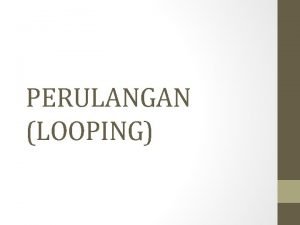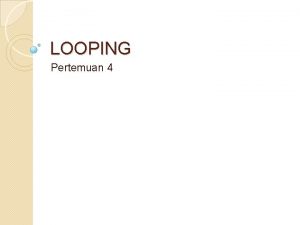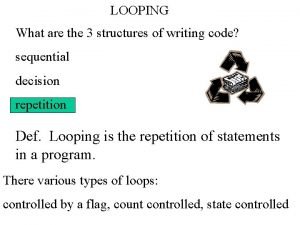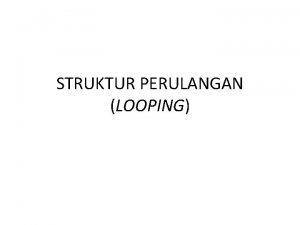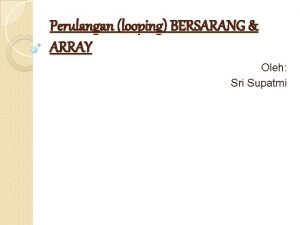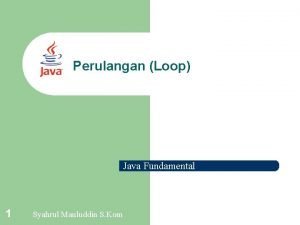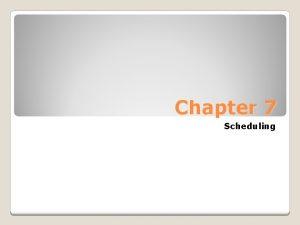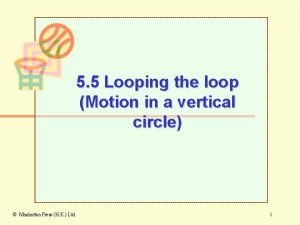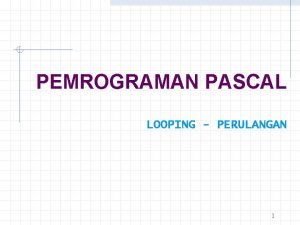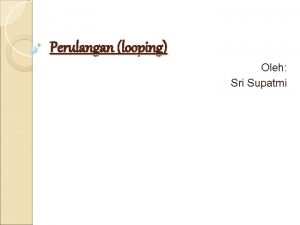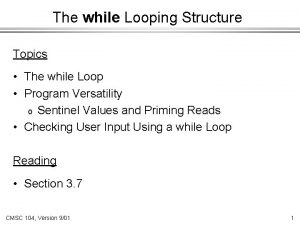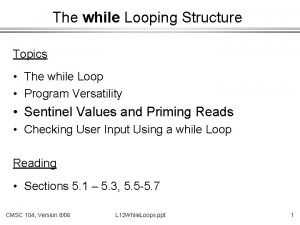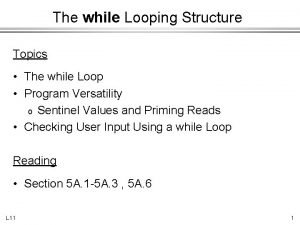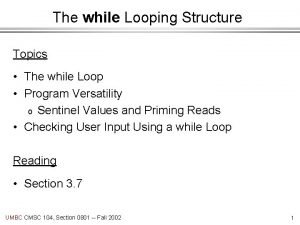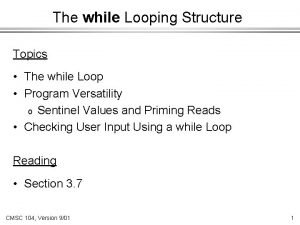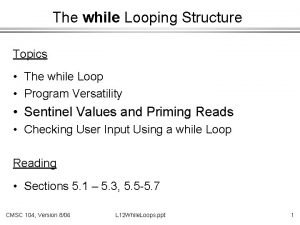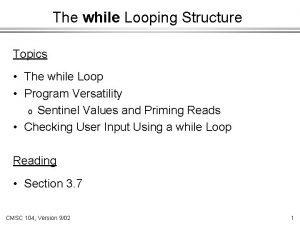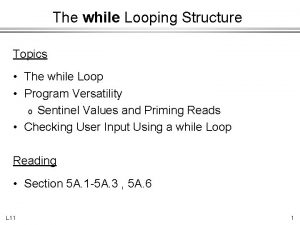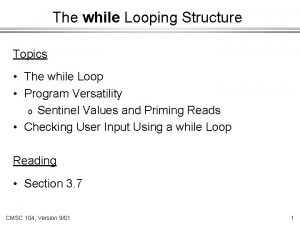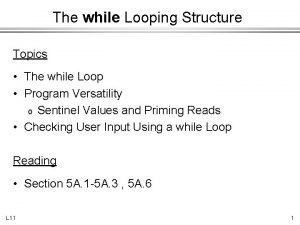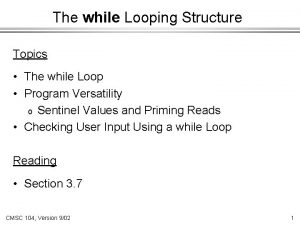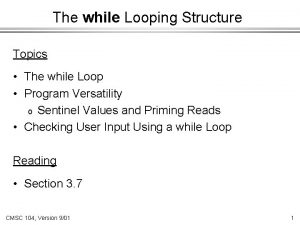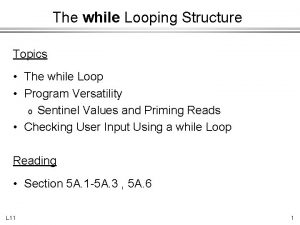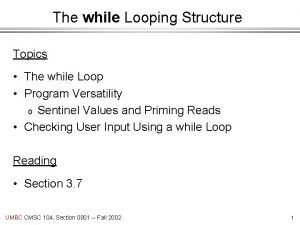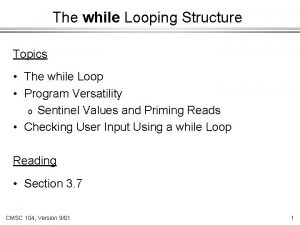The while Looping Structure Topics l l l



















- Slides: 19

The while Looping Structure Topics l l l The while Loop Program Versatility l Sentinel Values and Priming Reads Checking User Input Using a while Loop Reading l Section 3. 7 1

Review: Repetition Structure l l A repetition structure allows the programmer to specify that an action is to be repeated while some condition remains true. There are three repetition structures in C, the while loop, the for loop, and the do-while loop. 2

The while Repetition Structure while ( condition ) { statement(s) } The braces are not required if the loop body contains only a single statement. However, they are a good idea and are required by the 104 C Coding Standards. 3

Example while ( children > 0 ) { children = children - 1 ; cookies = cookies * 2 ; } 4

Good Programming Practice l l Always place braces around the body of a while loop. Advantages: l l Easier to read Will not forget to add the braces if you go back and add a second statement to the loop body Less likely to make a semantic error Indent the body of a while loop 3 to 4 spaces -- be consistent! 5

Another while Loop Example l l Problem: Write a program that calculates the average exam grade for a class of 10 students. What are the program inputs? l l the exam grades What are the program outputs? l the average exam grade 6

The Pseudocode <total> = 0 <grade_counter> = 1 While (<grade_counter> <= 10) Display “Enter a grade: ” Read <grade> <total> = <total> + <grade> <grade_counter> = <grade_counter> + 1 End_while <average> = <total> / 10 Display “Class average is: “, <average> 7

The C Code 1. 2. 3. 4. #include <stdio. h> int main ( ) { int counter, grade, total, average ; 5. 6. 7. 8. 9. 10. 11. 12. 13. 14. 15. 16. 17. } total = 0 ; counter = 1 ; while ( counter <= 10 ) { printf (“Enter a grade : “) ; scanf (“%d”, &grade) ; total = total + grade ; counter = counter + 1 ; } average = total / 10 ; printf (“Class average is: %dn”, average) ; return 0 ; 8

Versatile? l l How versatile is this program? It only works with class sizes of 10. We would like it to work with any class size. A better way : l Ask the user how many students are in the class. Use that number in the condition of the while loop and when computing the average. 9

New Pseudocode <total> = 0 <grade_counter> = 1 Display “Enter the number of students: “ Read <num_students> While (<grade_counter> <= <num_students>) Display “Enter a grade: ” Read <grade> <total> = <total> + <grade> <grade_counter> = <grade_counter> + 1 End_while <average> = <total> / <num_students> Display “Class average is: “, <average> 10

New C Code 1. 2. 3. 4. #include <stdio. h> int main ( ) { int num. Students, counter, grade, total, average ; total = 0 ; counter = 1 ; 5. 6. printf (“Enter the number of students: “) ; scanf (“%d”, &num. Students) ; while ( counter <= num. Students) { printf (“Enter a grade : “) ; scanf (“%d”, &grade) ; 7. 8. 9. 10. 11. total = total + grade ; counter = counter + 1 ; 12. 13. 14. } 15. average = total / num. Students ; printf (“Class average is: %dn”, average) ; return 0 ; 16. 17. 18. } 11

Why Bother to Make It Easier? l Why do we write programs? l l So the user can perform some task The more versatile the program, the more difficult it is to write. BUT it is more useable. The more complex the task, the more difficult it is to write. But that is often what a user needs. Always consider the user first. 12

Using a Sentinel Value l l l We could let the user keep entering grades and when he’s done enter some special value that signals us that he’s done. This special signal value is called a sentinel value. We have to make sure that the value we choose as the sentinel isn’t a legal value. For example, we can’t use 0 as the sentinel in our example as it is a legal value for an exam score. 13

The Priming Read l l l When we use a sentinel value to control a while loop, we have to get the first value from the user before we encounter the loop so that it will be tested and the loop can be entered. This is known as a priming read. We have to give significant thought to the initialization of variables, the sentinel value, and getting into the loop. 14

New Pseudocode <total> = 0 <grade_counter> = 1 Display “Enter a grade: “ Read <grade> While ( <grade> != -1 ) <total> = <total> + <grade> <grade_counter> = <grade_counter> + 1 Display “Enter another grade: ” Read <grade> End_while <average> = <total> / <grade_counter> Display “Class average is: “, <average> 15

New C Code 1. 2. 3. 4. #include <stdio. h> int main ( ) { int counter, grade, total, average ; total = 0 ; counter = 1 ; printf(“Enter a grade: “) ; scanf(“%d”, &grade) ; while (grade != -1) { total = total + grade ; counter = counter + 1 ; printf(“Enter another grade: “) ; scanf(“%d”, &grade) ; } 5. 6. 7. 8. 9. 10. 11. 12. 13. 14. average = total / counter ; printf (“Class average is: %dn”, average) ; return 0 ; 15. 16. 17. 18. } 16

Final “Clean” C Code 1. #include <stdio. h> 2. 3. 4. 5. 6. 7. 8. int main ( ) { int counter ; int grade ; int total; int average ; /* counts number of grades entered */ /* individual grade */ /* total of all grades */ /* average grade */ 9. 10. 11. 12. /* Initializations */ total = 0 ; counter = 1 ; 13. 14. 15. 16. 17. /* Priming read to get initial grade from user printf(“Enter a grade: “) ; scanf(“%d”, &grade) ; */ 17

Final “Clean” C Code (con’t) /* Get grades until user enters -1. Compute grade total and grade count. */ while (grade != -1) { total = total + grade ; counter = counter + 1 ; printf(“Enter another grade: “) ; scanf(“%d”, &grade) ; } 17. 18. 19. 20. 21. 22. 23. 24. 25. 26. /* Compute and display the average grade */ average = total / counter ; printf (“Class average is: %dn”, average) ; 27. 28. 29. 30. return 0 ; 31. 32. } 18

Using a while Loop to Check User Input 1. 2. 3. 4. 5. 6. #include <stdio. h> int main ( ) { int number ; printf (“Enter a positive integer : “) ; scanf (“%d”, &number) ; while ( number <= 0 ) { printf (“n. That’s incorrect. Try again. n”) ; printf (“Enter a positive integer: “) ; scanf (“%d”, &number) ; } printf (“You entered: %dn”, number) ; return 0 ; 7. 8. 9. 10. 11. 12. 13. 14. 15. } 19
 Flowchart perulangan for c++
Flowchart perulangan for c++ While loop forever
While loop forever While do loop
While do loop Program looping pascal
Program looping pascal What is looping in writing
What is looping in writing Bentuk umum dari pernyataan perulangan for adalah...
Bentuk umum dari pernyataan perulangan for adalah... Looping statement in qbasic
Looping statement in qbasic Looping bersarang
Looping bersarang Perulangan bersarang java
Perulangan bersarang java Disadvantages of looping in education
Disadvantages of looping in education Exit controlled loop flowchart
Exit controlled loop flowchart Dangling error in network
Dangling error in network Automatic counter loop flowchart
Automatic counter loop flowchart Loop aircraft motion
Loop aircraft motion Struktur dasar algoritma repetition
Struktur dasar algoritma repetition Digunakan untuk mengerjakan
Digunakan untuk mengerjakan For to do pascal
For to do pascal Looping and graphics in small basic
Looping and graphics in small basic Loop logic programming
Loop logic programming Struktur
Struktur
